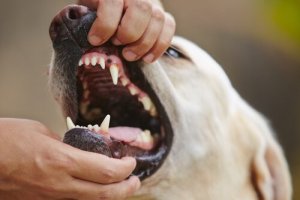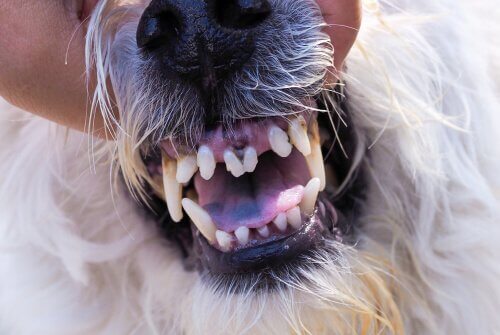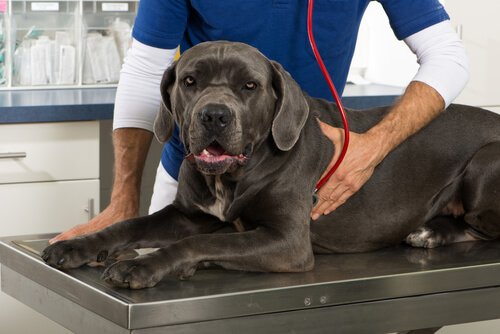Health Watch: Gingivitis Treatment for Dogs


Written and verified by the lawyer Francisco María García
Gingivitis is one of the most common oral infections in dogs, but luckily the treatment for it isn’t too complicated. It’s basically a progressive form of inflammation that attacks the gums, but it can even spread to the bone tissue if not kept under control.
Today, we’re going to talk about the symptoms and treatment for gingivitis in dogs, and how you can prevent it.
What causes gingivitis in dogs?
Most dental illnesses happen as a result of dental plaque buildup, and gingivitis is no exception. It generally happens with dogs if you don’t fight the plaque often enough, and it lives too long in your dog’s mouth. Let’s take a deeper look at exactly how it happens, so you can get a better idea of its symptoms and how to treat it.
There are some kinds of bacteria that live naturally in your dog’s mouth. When you don’t brush their teeth, you’re letting food scraps build up between their teeth and gums. That organic waste is food for the bacteria already living in your dog’s mouth. By “feeding” them, you’re helping them grow and spread much faster.
If that happens, it’ll lead to an overpopulation of those bacteria in your dog’s mouth. From there, plaque will start to form. Dental plaque sticks to their teeth, and once it reacts with the enamel and saliva, it ends up forming tartar.
Once the tartar sticks to your dog’s teeth, the bacteria keep on spreading. If you don’t do anything about it in time, they end up getting into its gums. That’s when the gum inflammation, or gingivitis, truly starts.

Symptoms of gingivitis in dogs
Gingivitis tends to develop and progress silently. The first symptoms are hard to diagnose at a quick glance. This is why it’s especially important to check your dog’s mouth periodically to make sure there aren’t any issues.
The first clear sign of gingivitis is generally a thin red line in the part where the teeth and gums meet. It’s also very likely that you’ll notice your dog’s gums are red and bigger than usual. If the gingivitis has already progressed, its gums might start to bleed or develop sores.
However, gingivitis can also bring some much more complex symptoms for dogs, especially without proper treatment. Here are some of the most common symptoms you’ll see:
- Halitosis (bad breath)
- Trouble chewing
- Loss of appetite
- Excessive salivation
- Constant scratching around the mouth
- Gingival hyperplasia (an unusual increase in gum size)
- Not letting you touch it around the mouth, or reacting negatively when you try
- Changes in behavior, generally related to the pain caused by the inflammation
If you don’t treat it in time, the bacteria will keep on pushing and get into the bone and muscle tissues next to the teeth. That could lead to a much more serious problem: periodontal disease, or gum disease. It’s a condition that can actually make your dog lose teeth.

Gingivitis treatment for dogs
If you spot any changes in your dog’s mouth or teeth, you should take it to the vet as soon as you can. They can examine your dog’s mouth and carry out all the tests to see how its oral health is, and how far the bacteria has gotten.
Gingivitis treatment for dogs depends a lot on what stage the condition is in. Antibiotics are generally a vital part of treatment, because it’s a bacterial illness.
In minor cases, the antibiotics are usually topical and help to relieve the inflammation and get rid of the bacteria. With more serious cases, the antibiotics might be pills or injections because your dog needs a much stronger medicine to fight against the spreading bacteria.
Your vet might also prescribe it some pain relievers to help with the pain and keep your dog from suffering too much during the treatment.
Surgery
If necessary, they may also perform surgery after the treatment to get rid of the tartar on your dog’s teeth. Doing that will help prevent the gingivitis from coming back. As usual, though, this depends on how healthy your dog is.
If the bacteria have reached the bone tissue in your dog’s mouth, your vet will have to check to see if the bone structure around its teeth has been damaged. If that’s the case, then they may have to do surgery to extract one or more of your dog’s teeth.
Gingivitis is one of the most common oral infections in dogs, but luckily the treatment for it isn’t too complicated. It’s basically a progressive form of inflammation that attacks the gums, but it can even spread to the bone tissue if not kept under control.
Today, we’re going to talk about the symptoms and treatment for gingivitis in dogs, and how you can prevent it.
What causes gingivitis in dogs?
Most dental illnesses happen as a result of dental plaque buildup, and gingivitis is no exception. It generally happens with dogs if you don’t fight the plaque often enough, and it lives too long in your dog’s mouth. Let’s take a deeper look at exactly how it happens, so you can get a better idea of its symptoms and how to treat it.
There are some kinds of bacteria that live naturally in your dog’s mouth. When you don’t brush their teeth, you’re letting food scraps build up between their teeth and gums. That organic waste is food for the bacteria already living in your dog’s mouth. By “feeding” them, you’re helping them grow and spread much faster.
If that happens, it’ll lead to an overpopulation of those bacteria in your dog’s mouth. From there, plaque will start to form. Dental plaque sticks to their teeth, and once it reacts with the enamel and saliva, it ends up forming tartar.
Once the tartar sticks to your dog’s teeth, the bacteria keep on spreading. If you don’t do anything about it in time, they end up getting into its gums. That’s when the gum inflammation, or gingivitis, truly starts.

Symptoms of gingivitis in dogs
Gingivitis tends to develop and progress silently. The first symptoms are hard to diagnose at a quick glance. This is why it’s especially important to check your dog’s mouth periodically to make sure there aren’t any issues.
The first clear sign of gingivitis is generally a thin red line in the part where the teeth and gums meet. It’s also very likely that you’ll notice your dog’s gums are red and bigger than usual. If the gingivitis has already progressed, its gums might start to bleed or develop sores.
However, gingivitis can also bring some much more complex symptoms for dogs, especially without proper treatment. Here are some of the most common symptoms you’ll see:
- Halitosis (bad breath)
- Trouble chewing
- Loss of appetite
- Excessive salivation
- Constant scratching around the mouth
- Gingival hyperplasia (an unusual increase in gum size)
- Not letting you touch it around the mouth, or reacting negatively when you try
- Changes in behavior, generally related to the pain caused by the inflammation
If you don’t treat it in time, the bacteria will keep on pushing and get into the bone and muscle tissues next to the teeth. That could lead to a much more serious problem: periodontal disease, or gum disease. It’s a condition that can actually make your dog lose teeth.

Gingivitis treatment for dogs
If you spot any changes in your dog’s mouth or teeth, you should take it to the vet as soon as you can. They can examine your dog’s mouth and carry out all the tests to see how its oral health is, and how far the bacteria has gotten.
Gingivitis treatment for dogs depends a lot on what stage the condition is in. Antibiotics are generally a vital part of treatment, because it’s a bacterial illness.
In minor cases, the antibiotics are usually topical and help to relieve the inflammation and get rid of the bacteria. With more serious cases, the antibiotics might be pills or injections because your dog needs a much stronger medicine to fight against the spreading bacteria.
Your vet might also prescribe it some pain relievers to help with the pain and keep your dog from suffering too much during the treatment.
Surgery
If necessary, they may also perform surgery after the treatment to get rid of the tartar on your dog’s teeth. Doing that will help prevent the gingivitis from coming back. As usual, though, this depends on how healthy your dog is.
If the bacteria have reached the bone tissue in your dog’s mouth, your vet will have to check to see if the bone structure around its teeth has been damaged. If that’s the case, then they may have to do surgery to extract one or more of your dog’s teeth.
All cited sources were thoroughly reviewed by our team to ensure their quality, reliability, currency, and validity. The bibliography of this article was considered reliable and of academic or scientific accuracy.
- Paula G. Toriggia. 2014. Enfermedad periodontal en el perro. Extraído de: http://repositoriouba.sisbi.uba.ar/gsdl/collect/posgrauba/index/assoc/HWA_1473.dir/1473.PDF
- M. Moreiro, X. Roura, A. Lloret, M. Planellas. 2008. Hospital Clínico Veterinario UAB-UPA. GINGIVOESTOMATITIS LINFOPLASMOCITARIA EN PERROS. Extraído de: https://ddd.uab.cat/pub/clivetpeqani/11307064v28n4/11307064v28n4p277.pdf
This text is provided for informational purposes only and does not replace consultation with a professional. If in doubt, consult your specialist.








